5.1 The student will demonstrate an understanding of scientific reasoning, logic, and the nature of science by planning and conducting investigations in which
d) hypotheses are formed from testable questions;
e) independent and dependent variables are identified;
f) constants in an experimental situation are identified;
g) data are collected, recorded, analyzed, and communicated using proper graphical representations and metric measurements;
h) predictions are made using patterns from data collected, and simple graphical data are generated;
i) inferences are made and conclusions are drawn;
k) current applications are used to reinforce science concepts.
5.2 The student will investigate and understand how sound is created and transmitted, and how it is used. Key concepts include
a) compression waves;
b) vibration, compression, wavelength, frequency, amplitude;
c) the ability of different media (solids, liquids, and gases) to transmit sound; and
d) uses and applications of sound waves.
- design an investigation to determine what factors affect the pitch of a vibrating object. This includes vibrating strings, rubber bands, beakers/bottles of air and water, tubes (as in wind chimes), and other common materials.
- rubber bands
- craft sticks
Students will work with rubber bands and craft sticks to investigate how the factors of length and tension in a rubber band affect the pitch it produces while intentionally trying to isolate these variables.
Included in the lab
Construction and Tips Regarding the Demonstration
None
Going to Great Lengths to Do Science!
How does the pitch created by “plucking” a rubber band depend on its length?
What do you think? Form a hypothesis and write it down.
Sketch the trend you predict will exist.
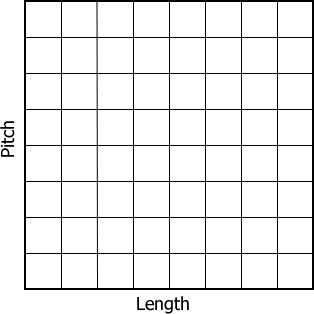
Get a rubber band and do a quick check. What trend
Do you find?
Sketch what you find to the below.

When you did your quick check, did you change the length of the rubber band by stretching it?

If you did, then you actually changed TWO things about your rubber band. You changed how long the rubber band was AND you changed the tension (the force of stretch) in the rubber band. That means we still don’t really know how the LENGTH of the rubber band affects its pitch. Plus now I wonder how does the tension in the rubber band affects its pitch? But to do a good science experiment I need to change one and only one thing at a time.
So let’s try again. Let’s go back to the original question. How does the length of the rubber band affect the pitch it produces when it is plucked?
Independent Variable _______________________Dependent Variable __________________________
(Write the word Length or Pitch in the blanks above. Remember, the Independent variable is the one I change and the Dependent variable depends on that change.)
Constants ______________________________________________________________________
List anything that must be kept constant so it doesn’t confuse the results.
Use the materials provided to help you conduct an experiment where you only change the length of the rubber band to see how that change affects the pitch it produces. Make sure you don’t allow any of the constants to change. On the back of this page write an explanation of how you did your experiment in a way that kept the tension the same while you changed the length of the rubber band.
How does the pitch created by “plucking” a rubber band depend on its length?

Now we know how the pitch of a plucked rubber band depends on the length of it. But we also uncovered another question. Good science always does! How does the tension in a rubber band affect the pitch it produces when plucked? For this new question we need to first identify our independent and dependent variables and any constants we need.
(Write the word Length, Tension, or Pitch in the blanks below. Remember, the Independent variable is the one I change and the Dependent variable depends on that change, and constants are things that must be kept constant so they don’t confuse our results.)
Independent Variable _______________________Dependent Variable __________________________
Constants ______________________________________________________________________
Use the materials provided to help you conduct an experiment where you only change the tension of the rubber band to see how that change affects the pitch it produces. Make sure you don’t allow any of the constants to change. On the back of this page write an explanation of how you did your experiment in a way that kept the leingth the same while you changed the tension of the plucked rubber band.
I will show you one method you may wish to use to do this. It’s a little tricky.
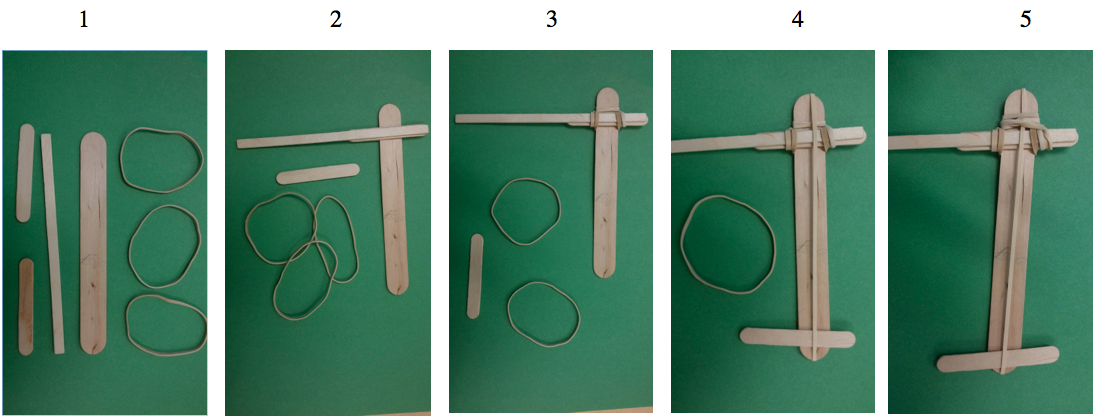
- Get the materials shown
- Lay a small craft stick across the large and lay the long skinny one across it
- Use a rubber band to wrap these three sticks together tightly
- Place a rubber band (the plucker) over the length of the long craft stick and slide the second small one between the rubber band and the long craft stick at the opposite end.
- Use the third rubber band to tightly wrap the plucker against the long craft stick so it doesn’t pinch the plucker between the two small craft sticks.
Now you have successfully engineered a tool to allow you to change the tension in the rubber band while keeping the length of the rubber band the same!
Here is how you use it.
- Place the long skinny craft stick up against your jaw bone just in front of the opening to your ear.
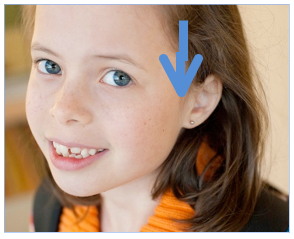
- Put your pointer finger on the small craft stick away from your ear and pluck the rubber band. You should hear the sound clearly.
- Change the tension in the rubber band by increasing the tension in the band by moving the small craft stick down and around back, pulling some band with it. Then slid it back in the original position. Each time you do this it will make the front side of the band have more tension in it.
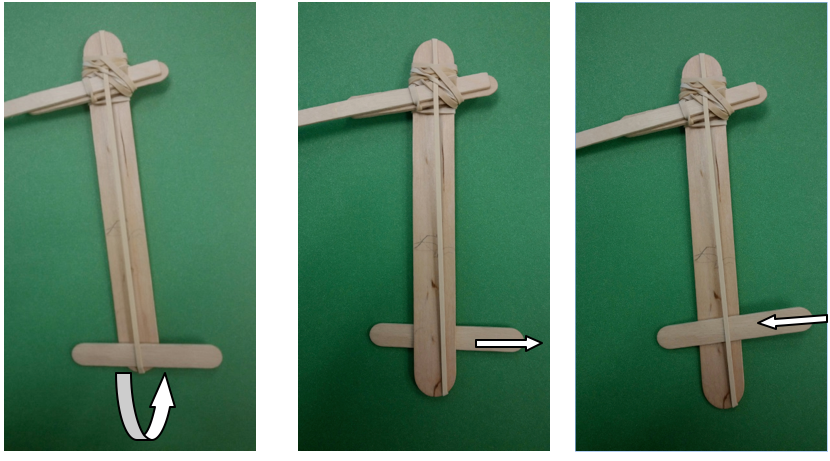
4 – Now you can gradually increase the tension and pluck the rubber band with each new tension to hear how its pitch has changed.
How does the pitch created by “plucking” a rubber band depend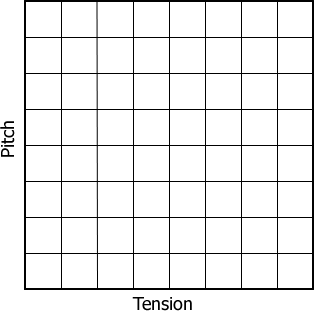
on its tension?